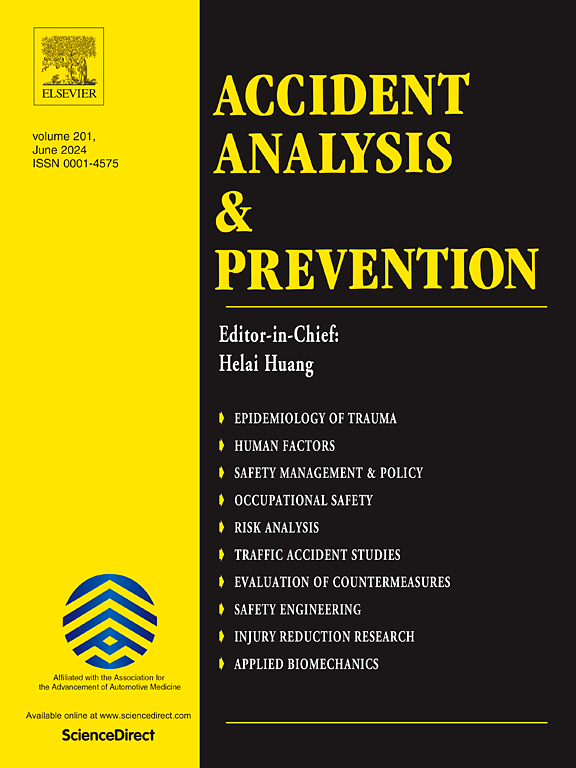使用基于人工智能的视频分析来检查无信号滑动车道上行人行为和安全的博弈理论模型
IF 5.7
1区 工程技术
Q1 ERGONOMICS
引用次数: 0
摘要
左转滑道,在右手驾驶的国家也被称为通道右转车道,广泛用于在有信号的十字路口方便左转弯。然而,行人在滑道上的安全问题并不为人所知。在无信号人行横道上,行人和驾驶者的共同决策过程是复杂的,涉及联合通信动态,但目前的研究主要集中在检查个人决策。本研究提出了一种基于博弈论的方法,将交互作用制定为两方,非合作,同时博弈,以检查这些联合决策动态,其结果行为和相关的崩溃风险。该方法比较了两种著名的博弈论均衡,即量子反应均衡(QRE)和纳什均衡(NE),基于在澳大利亚布里斯班的两条有斑马线的信号交叉路口收集的两天内每天跨越12小时的真实行人-驾驶者互动视频数据。基于人工智能的视频分析提取交互数据,并使用二元logit模型对其建模,以理解行人的过马路和让行决策。结果表明,QRE在预测行人过马路意愿和驾驶人让行意愿方面优于NE。结果表明:a)车速越高,驾驶人越不愿意让行人;b)行人从路边过马路,驾驶人越愿意让行人;c)人车距离越长,驾驶人越愿意让行人。根据QRE模型,发生冲突的概率为5.8%,表明在这些滑道中行人与车辆的交互中有5.8%会导致冲突。同样,混淆概率表明,在有斑马线的十字路口,即使司机在滑动车道上让行斑马线,仍有5.2%的行人对是否开始穿越斑马线感到困惑。本研究强调了使用基于博弈论的方法来理解道路使用者在滑道上的行为的重要性。这些发现可以帮助识别行人过马路的意图,并支持联网自动驾驶汽车做出停车决定,以提高行人安全,减少与其他道路使用者的潜在冲突。本文章由计算机程序翻译,如有差异,请以英文原文为准。
A game theoretical model to examine pedestrian behaviour and safety on unsignalised slip lanes using AI-based video analytics
Left-turn slip lanes, also known as channelised right-turn lanes in right-hand driving countries, are widely implemented to facilitate left-turning at signalised intersections. However, pedestrian safety on slip lanes is not well known. At unsignalised crosswalks, the joint decision-making process of both pedestrians and motorists is complex, involving joint communication dynamics, yet current research primarily focuses on examining individual decisions. This study proposes a game theory-based approach, formulating the interaction as a two-player, non-cooperative, simultaneous game to examine those joint decision-making dynamics, their resulting behaviours, and associated crash risks. The approach compares two well-known equilibriums of game theory, namely Quantal Response Equilibrium (QRE) and Nash Equilibrium (NE), based on real-world pedestrian-motorist interaction video data collected over two days, each day spanning 12 h, from two slip lanes with zebra crossings at signalised intersections in Brisbane, Australia. Artificial intelligence-based video analytics extracted interaction data, which was modelled using binary logit models to understand the crossing and yielding decisions of pedestrians. Results demonstrate that the QRE outperforms the NE in predicting the crossing intention of pedestrians and the yielding intention of motorists. Results indicate that a) motorists are less likely to yield to pedestrians when the vehicle speed is higher, b) pedestrians are more likely to let the motorists go first if they start crossing from the curbside of the road, and c) motorists are more likely to yield to pedestrians when the distance between pedestrians and vehicles is longer. According to the QRE model, the probability of conflict is 5.8%, indicating that 5.8% of pedestrian interactions with vehicles in these slip lanes result in conflicts. Similarly, the confusion probability indicates that about 5.2% of pedestrians were confused about initiating crossing in the presence of zebra crossing even though drivers yielded them on slip lanes at signalised intersections. This study highlights the significance of using game theory-based approaches to understand road users’ behaviour on slip lanes. These findings can help to identify pedestrian crossing intentions and support connected automated vehicles in making stopping decisions to enhance pedestrian safety and reduce potential conflicts with other road users.
求助全文
通过发布文献求助,成功后即可免费获取论文全文。
去求助
来源期刊

Accident; analysis and prevention
Multiple-
CiteScore
11.90
自引率
16.90%
发文量
264
审稿时长
48 days
期刊介绍:
Accident Analysis & Prevention provides wide coverage of the general areas relating to accidental injury and damage, including the pre-injury and immediate post-injury phases. Published papers deal with medical, legal, economic, educational, behavioral, theoretical or empirical aspects of transportation accidents, as well as with accidents at other sites. Selected topics within the scope of the Journal may include: studies of human, environmental and vehicular factors influencing the occurrence, type and severity of accidents and injury; the design, implementation and evaluation of countermeasures; biomechanics of impact and human tolerance limits to injury; modelling and statistical analysis of accident data; policy, planning and decision-making in safety.
 求助内容:
求助内容: 应助结果提醒方式:
应助结果提醒方式:


